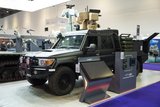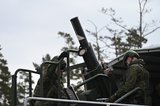Comprehensive Counter-Drone Capability, Soft, Hard and Directed Energy Kill Ready (sponsored)
This article is brought to you by Electro Optic Systems Pty Limited (EOS).
It is expected that unmanned aerial systems (UAS) will be used increasingly for malicious purposes as the cameras, weapons, toxic chemicals and explosives they are able to carry will be used for acts of terrorism, espionage and smuggling.
The Titanis Counter UAS (C-UAS) system has been developed by Electro Optic Systems (EOS) to address the growing threat from malicious and threatening unmanned aircraft system
Based on the EOS R-Series family of remote weapon stations (RWS), Titanis is a fully integrated, scalable C-UAS suite combining specific detection, command and control (C2), and layered hard and soft kill defeat capabilities necessary to acquire, track, and defeat swarming UAS threats.
The Titanis system allows the operators to match kill solutions to large numbers and varying combinations of small and large drones to ensure that the threat can be mitigated regardless of their direction, numbers and capabilities while managing the environmental, geographic, airspace and personnel safety considerations.
Flexible lethality options from 7.62mm MG to 35kW directed energy
A typical Titanis configuration incorporates direct fire engagement systems, passive and active soft kill electronic warfare (EW) systems, an integrated sensor suite - including Pulse-Doppler, software-defined radar, day/thermal camera, laser rangefinder and radio frequency (RF) detection systems - and an optional directed energy (DE) kill system. These systems sit together with, and are integrated through, a proprietary C2 and fire control system developed by EOS.

High volume fire, point defence solutions, range from the 7.62mm Dillon Aero M134- series minigun to larger calibre 30mm guns (e.g. the Northrop Grumman M230LF 30mm cannon with EOS R400S Mk2 RWS, or Mk44 II Bushmaster chain gun with the heavier weight EOS R800 RWS) firing airburst munitions (including 30mm x 113mm proximity fused airbursts and 30mm x 173mm airburst rounds) to deliver C-UAS effects out to 3000m.
Less than 8 seconds detect to defeat on all drone threats
One of the key differences between C-UAS and other missions is the high angular speed that can be achieved by the UAS at relatively short range. EOS RWS have been modified with a fourth-axis independently slewing sensor unit that can move independently in azimuth to track fast-moving targets. A 1-Hz laser provides laser ranging and tracking throughout the engagement.
Passive and active soft kill EW systems, designed to operate across all-threat frequency bands are, as with the radar solutions, integrated according to customer preference. Typical solutions include offerings from Blighter in the UK, Echodyne in the US and RADA in Israel.

Titanis’ DE system has been deployed with a 35kW high energy laser (HEL), although the HEL in its current format is capable of scaling to around 55kW. The HEL system has been demonstrated as a small containerised system; however, while the DE beam director is slightly different to a weapons station it has 60% commonality with the R400S RWS and will therefore be employable from deployable platforms.
Developed and manufactured in-house by EOS, the DE system – which includes the beam director, and co-mounted optical target identification and tracking system – is designed to address Groups I, II, and III UAS swarm threats, with high rates of target engagement, out to ranges of 4000m.
The ability to maintain and manage the quality of the beam, the software that ensures precision engagement and drives the process, and all the mechanical designs and architectures, are all EOS designs and intellectual property.
Arguably, the largest growth rate in lightweight lethality systems is in the unmanned systems space, for both integration on unmanned platforms with remote operation, and also for the engagement and defeat of unmanned systems. In a C-UAS application, Titanis with direct engagement/point defence, passive and active EW and directed energy capabilities constitutes a significant force multiplier.
Click for further information on Titanis
Electro Optic Systems (EOS) is a leading ASX-listed Australian owned and operated Defence, Space and communications company. EOS has designed, manufactured and exported advanced technology systems for over 35 years. The company is a world leader in space information and intelligence services; optical sensor units; kinetic and directed energy weapon systems, and ultra-secure, ultra-high capacity optical and microwave products for land, maritime and space communications. EOS has recently extended its capabilities to include battlefield command and communications systems and guided weapons. Please contact [email protected] for further information.
More from Industry Spotlights
-
![De-Risking the Future: Manufacturing Certainty for Unmanned Systems]()
De-Risking the Future: Manufacturing Certainty for Unmanned Systems
How strategic manufacturing partnership solves the industrialisation triad — Scale, Compliance and Cost — for hyper-growth defence tech innovators.
-
![Battlefield mobility, made in the UK]()
Battlefield mobility, made in the UK
How does Britain ensure that we can preserve the lives of our soldiers and allies – now and in the future – with homegrown innovation and resilient domestic manufacturing? At Pearson Engineering, we are proud to be a central part of the answer to this increasingly important question.
-
![Strengthening Baltic defence capabilities]()
Strengthening Baltic defence capabilities
How Latvia is bolstering its territorial defences, industrial capacity and international cooperation with Dynamit Nobel Defence’s SKORPION2 Remote Mining System.
-
![Barco’s vision to trust: from past to future]()
Barco’s vision to trust: from past to future
Barco’s story is one of constant evolution enabling more immersive, reliable, and future-ready training experiences.
-
![How are next-generation ejection seats helping pilots when they need it most?]()
How are next-generation ejection seats helping pilots when they need it most?
The ACES 5 ejection seat from RTX’s Collins Aerospace introduces new, innovative and patented technologies to help save lives.
-
How Patria TREMOS redefines battlefield mobility
The war in Ukraine has made it clear: the battlefield waits for no one. Military operations now take place in fast-paced environments, and speed is not just about the fight itself – it is about the entire ecosystem of warfare.


























